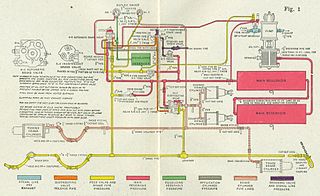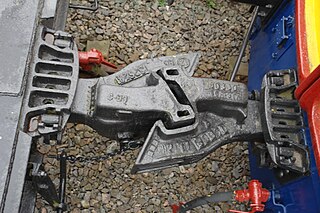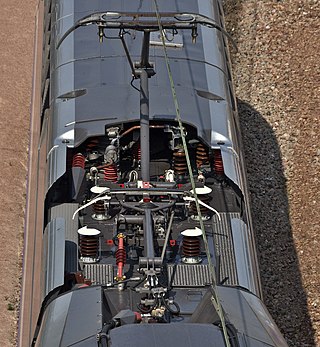
A railway air brake is a railway brake power braking system with compressed air as the operating medium. Modern trains rely upon a fail-safe air brake system that is based upon a design patented by George Westinghouse on April 13, 1869. The Westinghouse Air Brake Company was subsequently organized to manufacture and sell Westinghouse's invention. In various forms, it has been nearly universally adopted.

A coupling or coupler is a mechanism, typically located at each end of a rail vehicle, that connects them together to form a train. The equipment that connects the couplers to the vehicles is the draft gear or draw gear, which must absorb the stresses of the coupling and the acceleration of the train.

A bank engine, banking engine, helper engine or pusher engine is a railway locomotive that temporarily assists a train that requires additional power or traction to climb a gradient. Helpers/bankers are most commonly found in mountain divisions, where the ruling grade may demand the use of substantially greater motive power than that required for other grades within the division.

Rail freight transport is the use of railways and trains to transport cargo as opposed to human passengers.

The Indian locomotive class WAP-7 is a class of 25 kV AC electric locomotives that was developed in 1999 by Chittaranjan Locomotive Works (CLW) for Indian Railways. The model name stands for broad gauge (W), AC Current (A), Passenger traffic (P) locomotive, 7th generation (7). They entered service in 2000. A total of 1676 WAP-7 have been built, with more units being built at CLW, Banaras Locomotive Works (BLW) and Patiala Locomotive Works (PLW).

A buffer is a part of the buffers and chain coupler system used on the railway systems of many countries, among them most of those in Europe, for attaching railway vehicles together.
Type H Tightlock couplers are a variety of Janney coupler, typically used on North American mainline passenger rail cars. They have mechanical features that reduce slack in normal operation and prevent telescoping in derailments, yet remain compatible with other Janney types used by North American freight railroads.
The African Union of Railways is an organisation under the auspices of the new African Union dealing with railways. It is similar to the International Union of Railways (UIC).

SA3 couplers or Willison coupler and Russian coupler are railway couplings used primarily in Russia and states influenced by the former Soviet Union, such as Finland, Poland, and Mongolia.
The railcar couplers or couplings listed, described, and depicted below are used worldwide on legacy and modern railways. Compatible and similar designs are frequently referred to using widely differing make, brand, regional or nick names, which can make describing standard or typical designs confusing. Dimensions and ratings noted in these articles are usually of nominal or typical components and systems, though standards and practices also vary widely with railway, region, and era. Transition between incompatible coupler types may be accomplished using dual couplings, a coupling adapter or a barrier wagon.

A barrier vehicle (BV), barrier wagon, match wagon or translator coach is used to convert between non-matching railway coupler types. This allows locomotives to pull railway vehicles or parts of a train with a different type of coupler. A match wagon has an identical dual coupling at both ends.
Janney couplers are a semi-automatic form of railway coupling that allow rail cars and locomotives to be securely linked together without rail workers having to get between the vehicles. They are also known as American, AAR, APT, ARA, MCB, knuckle, Buckeye, tightlock or Centre Buffer Couplers.

The Class E 50 is an electric heavy freight locomotive built for German Federal Railways between 1957 and 1973. It belongs to the Einheits-Elektrolokomotiven program and was built as a heavy freight mover to be used on the increasingly electrified main lines of the DB, where they were set to replace the steam traction. In 1968 the series was redesignated as class 150 (E50). Originally the Class 150 was also suitable for passenger service; however, it did not have any steam or electric heating capability for the passenger coaches.
From time to time, a railway decides that it needs to upgrade its coupling system from one that is proving unsatisfactory, to another that meets future requirements. This can be done gradually, which can create many problems with transitional incompatibilities, or overnight, which requires much planning.

Faiveley Transport, formerly Faiveley, is an international manufacturer and supplier of equipment for the railway industry founded in 1919. It introduced the single-arm pantograph in 1955. The company has subsidiaries in more than 24 countries. The majority of Faiveley Transport's outstanding stock is owned by Wabtec, which acquired majority stock ownership from the Faiveley family in 2016.

Dellner Couplers AB is a Swedish original equipment manufacturer of train connection systems as couplers, gangway systems and dampers. The headquarter of the company is located in Vika in the Falun Municipality. Dellner is owned by the investment organisation EQT AB and has 19 subsidiaries worldwide with around 1,100 employees. In 2018, the company generated annual sales of around SEK 1.9 billion.
Buffers and chain couplers are the de facto International Union of Railways (UIC) standard railway coupling used in the EU and UK, and on some railways in other parts of the world, such as in South America and India, on older rolling stock. Buffers and chain couplers are an assembly of several devices: buffers, hooks and links, or turnbuckle screws.

Different types of railroad rolling stock have different couplers depending on the purpose and type of equipment being used and its intended destination. European rolling stock tend to use buffers and chain couplers while American rolling stock uses a Janney coupler or "knuckle coupler". These are incompatible with each other, but where some railroads have obtained older, less expensive used rolling stock from different countries or regions, instead of having to standardize on one form of coupler, it may be useful to be able to use either type of coupler on a piece of rolling stock without having to remove anything.

The balance lever coupling, also known as rocking lever coupling or compensating coupling, is a type of central buffer coupling that has found widespread use, especially in narrow-gauge railways. In Switzerland this type of coupling is called a central buffer with two screw couplings, abbreviated to Zp2, or referred to as a central buffer coupling with coupling hooks on the side
Digital automatic coupling (DAC) is a type of railway coupling developed in the 2020's to replace the English buffers and chain couplings, initially in Europe.















